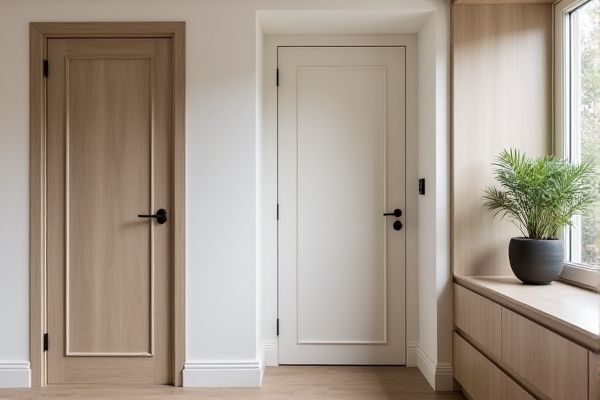
Handle-less pantry doors offer a sleek, minimalist look that enhances kitchen aesthetics while making cleaning easier since there are no protruding handles to collect dust or grime. If you want to explore which door style best suits your kitchen design and functionality needs, read the rest of the article.
Table of Comparison
| Feature | Handle-less Pantry Door | Handle Pantry Door |
|---|---|---|
| Design | Sleek, modern, minimalist | Traditional, varied styles |
| Operation | Push-to-open or recessed grip | Pull with external handle |
| Cleaning | Easy, smooth surface | Handles require separate cleaning |
| Installation | Complex, may need specialized hardware | Simple, standard handle mounting |
| Durability | Less wear on hardware | Handles prone to loosening/damage |
| Cost | Typically higher upfront | Generally more affordable |
| Aesthetic Impact | Seamless, enhances modern kitchens | Customizable, adds character |
Introduction to Pantry Door Designs
Handle-less pantry doors offer a sleek, minimalist aesthetic that enhances modern kitchen designs by eliminating protruding hardware, creating a seamless surface. Handle doors, featuring visible pulls or knobs, provide tactile ease and classic appeal, allowing for diverse stylistic expressions from traditional to contemporary. Choosing between handle-less and handle pantry doors largely depends on desired kitchen ergonomics, maintenance preferences, and overall design coherence.
What Is a Handle-less Pantry Door?
A handle-less pantry door features a sleek, modern design without traditional knobs or pulls, utilizing push-to-open mechanisms or recessed grips for seamless access. This style enhances minimalist kitchen aesthetics while reducing visual clutter and potential snag points. You benefit from an easy-to-clean surface and a streamlined appearance, ideal for contemporary pantry solutions.
Key Features of Handle Pantry Doors
Handle pantry doors offer tactile grip points that enhance ease of use and provide a traditional aesthetic appeal, often featuring knobs or pulls that complement kitchen design styles. These doors typically allow for precise opening control, beneficial in busy kitchens or for heavier door materials. Handle-less pantry doors, by contrast, prioritize sleek, minimalist looks, often incorporating push-to-open mechanisms or recessed grips that maintain a seamless cabinet facade.
Aesthetic Appeal: Handle-less vs Handle Doors
Handle-less pantry doors offer a sleek, minimalist aesthetic that seamlessly integrates with modern kitchen designs, creating a clean and uncluttered look. Handle doors provide a more traditional and tactile element, allowing for decorative hardware that can enhance the overall style and add character to the space. Your choice between the two influences the kitchen's visual impact, balancing contemporary elegance with personalized detail.
Space Efficiency and Door Functionality
Handle-less pantry doors maximize space efficiency by eliminating protruding hardware, allowing for seamless integration within tight kitchen layouts and reducing obstruction in narrow aisles. These doors often feature push-to-open or recessed grip mechanisms, enhancing sleek design while maintaining easy accessibility. In contrast, handle doors provide a more traditional grip, potentially requiring extra clearance but offering tactile feedback and varied stylistic options that can complement different kitchen aesthetics.
Ease of Use: Which Is More Convenient?
Handle doors offer a tactile grip, making them straightforward and intuitive to open, especially when your hands are full or wet. Handle-less pantry doors, often featuring push-to-open or recessed grip mechanisms, provide a sleek, modern aesthetic but may require a slight adjustment period for seamless operation. Your choice depends on whether you prioritize immediate convenience or a minimalist design that enhances kitchen aesthetics.
Cleaning and Maintenance Comparisons
Handle-less pantry doors offer a sleek surface that simplifies cleaning by reducing areas where dust and grime accumulate, unlike handle doors that require extra attention around hardware. The absence of handles eliminates crevices, making maintenance quicker and minimizing the collection of fingerprints and smudges on your pantry. For effortless upkeep, handle-less designs provide a practical advantage over traditional handle doors.
Safety Considerations: Handle-less vs Handle Doors
Handle-less pantry doors reduce the risk of clothing or jewelry getting caught, enhancing overall safety, especially in homes with children or elderly individuals. Handle doors provide a tactile grip but can pose a hazard by protruding into walkways, increasing the chance of bumps or accidental snags. Choosing a handle-less design can improve safety in tight kitchen spaces while maintaining a sleek, modern aesthetic.
Cost Differences Between Handle-less and Handle Doors
Handle-less pantry doors typically incur higher initial costs due to advanced mechanisms such as push-to-open systems or integrated finger pulls, whereas traditional handle doors are generally more affordable with standard knobs or pulls. Installation expenses may also vary, with handle-less designs requiring precise fitting and specialized hardware that can elevate labor costs. Over time, maintenance costs for handle-less doors can be lower due to fewer moving external parts, while handles may need regular tightening or replacement.
Choosing the Right Pantry Door for Your Kitchen
Handle-less pantry doors offer a sleek, modern aesthetic and promote seamless kitchen design by integrating flush with cabinetry surfaces, making them ideal for minimalist spaces. In contrast, handle doors provide tactile ease and classic style, supporting better grip and accessibility, especially in busy kitchens. Selecting the right pantry door depends on balancing the kitchen's design theme with functional needs, prioritizing ease of use versus contemporary visual appeal.
 homyna.com
homyna.com